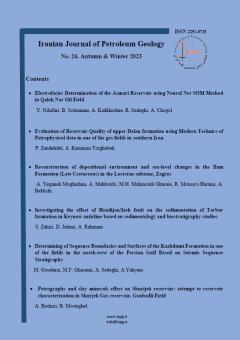Petrography, mineralogy and clay minerals, An attempt to reservoir characterization of Shurjeh reservoir, Gonbadli Gas Field
Subject Areas : Petroleum Reservoir GeologyAlireza Bashari 1 , Bijhan Mostaghel 2
1 - Research Institute of Petroleum Industry (RIPI)
2 - Head of Oil and Gas Exploration and Production department, Petro Kaveh Group, Tehran, Iran
Keywords: Gonbadli Gas field, shurjeh, Petrography clay mineralogy, Petrophysics,
Abstract :
Petrography and clay mineralogical study on DII, DI memebers of shurjeh gas reservoir ( sand stones) , and upper member of DII shows , presence of different type of minerals, as well as clay minerals , such as calcite, gluconate, Pyrite, Iron oxide, interbedd with silty & clay layers. Petrography studies along with XRD, XRF, EDX, SEM on the present samples, indicates presence of, kaolinite , illite chlorite and expandable clay minerals. Expandable clay comprise smectite and mixed layer or interstratified Illite / Smectite ( I/S) .Clay minerals have a tendency to change permeability of the rock, and hinder the passage of fluids. Kolinite may also cause varying degrees of impaired permability on contct with fresh water.The presence of interstitial clay drastically increase microprosity whilst at the same time reducing effective prosity. Petrography study shows , the mineralogical composition of reservoir rock comprised, Sublitharenites , using nomenclature of Folk, 1980., in general , 75% Quartz, 6% Feldspar and 15% Rock Fragments. Presence of different clay minerals in pore networks may have a significant impact on petrophysical properties of reservoir and hence affect reservoir productivity.
[1] مستقل. ب.، 1383 کار برد انالیز و مدل سازی استوکاستیک ( ناقاطع) در خلال مطالعات جامع ویژگیهای مخزن گازی گنبدلی ( مرز ایران ترکمنستان) پایان نامه دکترا ، دانشگاه آزاد اسلامی ، واحد علوم تحقیقات.
[2] مستقل، ب.، بشری ع. و خاکزاد، ا.، كاربرد آناليز و مدل سازي استوكاستيك ( ناقاطع ) در خلال مطالعات جامع ويژگيهاي مخزن گازي گنبدلي ( مرز ايران و تركمنستان ) مجله علمی پژوهشی علوم پایه دانشگاه ازاد اسلامي تهران، سال پانزدهم، پاییز 1384 شماره 57 ، پاییز 1384، ص 327-340،
[3] دهکار، ع.، بشری، ع.، و اصلانی، س.، مطالعه ژیوشیمیایی و پتروفیزیکی بروی کانی های رسی بخش E سازند قم ، میدان گازی سراجه قم، نشریه علمی-پژوهشی زمین شناسی نفت ایران ، سال اول ، شماره 2 ، پاییز-زمستان 1390 ص 35 -47.
[4] دهقانی، ز.، سلیمانی ، ب،. ارزیابی ژئوشیمیایی و محیط رسوبی واحدهای شیلی سازند پابده -گورپی و تاثیر کانیهای رسی در پایداری دیواره چاه، مطالعه موردی: میدان نفتی آغاجاری ، نشریه علمی-پژوهشی زمین شناسی نفت ایران، سال دوازدهم، شماره 23، بهار و تابستان 1401ص106- 128
[5] Afshar Harb , A., 1979. The Stratigraphy, Tectonics and Petroleum geology of Kopet- Dagh region, North Iran, Ph.D thesis, petroleum geology section , Royal school of mines Imperial college, London.
[6] Mohtadi Haghighi, J., 1987. An investigation on Gas-bearing sandstones in Shurijeh formation , GONBADLI structure, D- Zone.NIOC-EXP
. [7] Moussavi-harami,R& Bernner,R.L ., 1990. Lower Cretaceous( Neocomian) fluvial deposits in eastern Kopet-dagh basin, N-E of Iran: Cretaceous Research, v.11, p.163174
[8] Mostaghel., B, Bashari, A., & Khakzad., A., Application of Stochastic Analysis & Modelling through Integrated Reservoir Characterization in Gonbadli Gas field (North Eastern of the Iran), (66th EAGE Conference & Exhibition, 6-10 June, 2004, Paris).
[9] Bashari, A., Mostaghel., B & Khakzad., A., َApplication of Stochastic Analysis & Modelling through Integrated Reservoir Characterization in Gonbadli Gas field, North Eastern of the Iran, (AAPG International Conference & Exhibition Oct 24-27 2004, Cancun, Mexico).
[10] Bashari, A., Mostaghel., B , Khakzad., A., Amin Sobhani, A,. Application of Stochastic Analysis & Modelling through Integrated Reservoir Characterization in Gonbadli Gas field, North Eastern of the Iran, ( 32nd International Geological Congress, Florence_Italy August 20-28, 2004).
(11). Bashari , Alireza., 2000. Petrography and clay mineralogy of Volcanoclastic Sandstones in the Rewan Group, Southern, Bowen Basin, Australia, (Journal of Petroleum Geoscience, Vol.6, pp.151-163).
(12) Bashari, A., An attempt to reservoir characterization of Burgan sand, in the northwest of the Persian Gulf toward Kuwait (Iranian Journal of Petroleum Geology, No. 18, Autumn & Winter 2019, pp.102-120).
M.Mckineley, R.H.Worden & A.H. Ruffel,. 2003. Smectite in [13]
Sandstones : A review of Controls on Occurrence and Behaviour during Diagenesis, Int. Assoc.Sedimental.Spec.Publ.( 2003) 34, 109-128
Folk, R.L.1980Petrology of Sedimentary Rocks.Hemphill, Austin, Texas [14]
